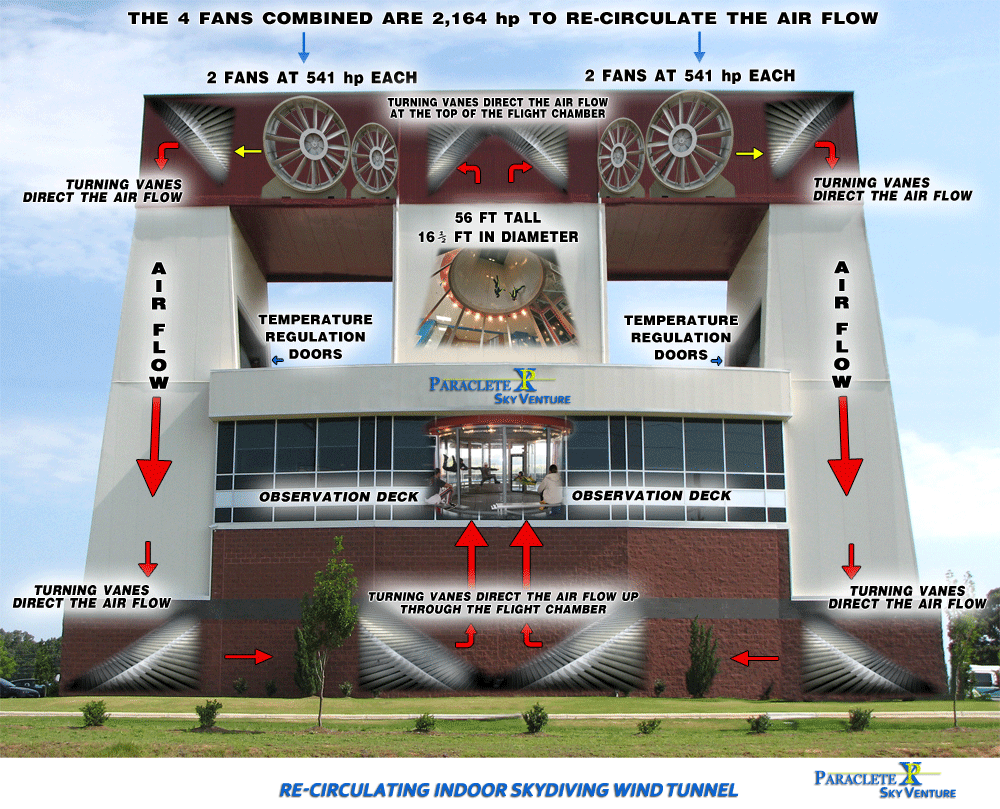
Inside the science of indoor skydiving’s wind tunnels
Wednesday, September 23, 2020
- Team XP
- 9/23/20
- 0
- Indoor Skydiving
As is true with much technology, vertical wind tunnels were first designed and built by the military. In the case of the initial upright designs, they were created to test the properties of aircraft and initially had nothing to do with flying people.
Although those were the days when there was still uncertainty about whether any bodily control in free-fall was possible, it is fairly easy to imagine the growing confidence of the military scientists observing their various wooden model planes move around in the wind and getting ideas. Humans are an inquisitive bunch, so it was not long before someone would jump in and give it a try — just like the wind tunnels Paraclete XP and indoor skydiving know today.
Wall-To-Wall Wind
Early commercial indoor skydiving wind tunnels were fairly crude – being little more than a repurposed plane engine mounted in a big frame, upturned for the propeller to blast wind through a wire net above which people could fly. While strong enough in the center for basic positions and small maneuvers, the wind generated by this type of design would quickly dissipate away from the very middle, causing people to slide off the airflow. In order for increasingly sophisticated flying and a more realistic environment, people would need to be able to perform their moves without slipping off the edges of the relative wind. This was achieved by adding walls, and although flyers would now have to be careful not to bump into them too hard, having consistent airflow throughout what was now the ‘flight chamber’ made a huge difference.
Recirculating Air
Even with the science advancing quickly – there was still a big breakthrough to be made. Even after switching out the noisy and unreliable aircraft piston engines for powerful and efficient electric motors they were still positioned under the fight chamber. The wind would be drawn in from under the structure, through the flight chamber, and then up into the open sky. It takes a lot of power to get a continual stream of wind up to over 150mph – what if there was a more efficient way to harness the energy used? Turns out, there was. From this point on, new wind tunnels were constructed with return towers, down which the wind – already at speed – was effectively saved to be used again. Not only did this make everything much more efficient, but it also allowed for additional benefits such as faster control of the fans and the ability to precisely manage the temperature inside the chamber. Also – they could be scaled up.
Skydiving Training Technique
As tunnels grew in size, the techniques we use for training evolved. Initially considered as a tool by which to develop skydiving skills, people began to learn the subtleties of the two environments. In the beginning, when you are new to it – skydiving skills and indoor bodyflight look and feel very much the same, yet as you progress you begin to notice where there are differences. Yes, indoor skydiving will make you good up in the sky too, but things have grown to the point where indoor bodyflight is practiced and recognized as a sport in its own right. The two things will always be connected – but you don’t need to be a skydiver to fly!

Go Big or Go Home
These advances with applied science meant that the indoor skydiving industry was all set for massive expansion. A few facilities became dozens, and dozens became hundreds. Even now, the most popular size for a professional flight chamber is 14ft – with this being the most efficient trade-off between functionality and cost. At Paraclete XP we want our flyers to have the best experience possible – which is why our flight chamber has a 16ft diameter – to this day the largest in the United States. 16ft allows not only for all the space you could ever need for personal training – you can fly with more of your friends here than anywhere else.
Industry Standard
These days we understand very well how the science of wind tunnels work, and with hundreds of commercial facilities around the world, indoor flying is here to stay. Here at XP we have been here since the early days, and have – along with both the facility and the team – the experience to make your indoor skydiving training the very best on offer. For a long time now our tunnel home has been considered one of the very best in the world, and we intend to remain that way.
Ready to give our wind tunnel a try? Contact us today to learn more about your options and to schedule your visit. Oh, and did we mention, we have the largest wind tunnel in the United States?
Copyright © 2025, Paraclete XP Indoor Skydiving, All Rights Reserved.
DropZone Web Design & Marketing by Beyond Marketing, LLC
